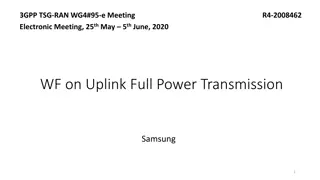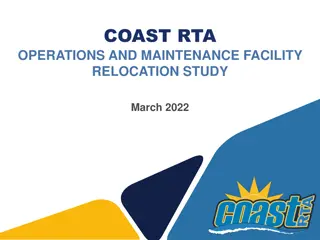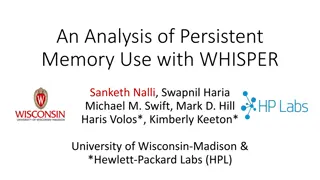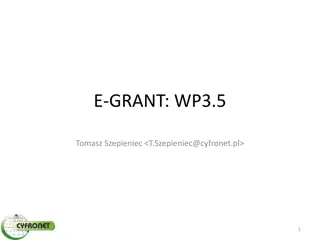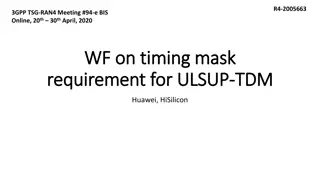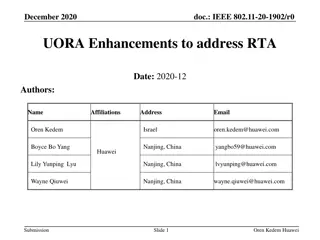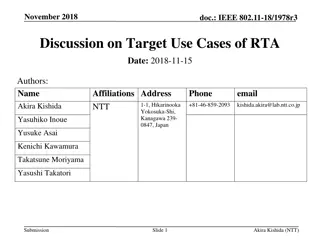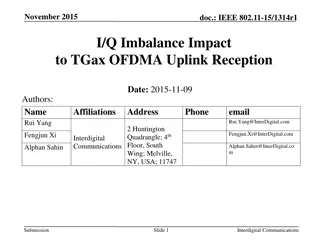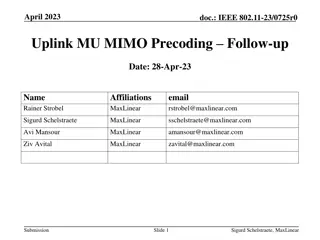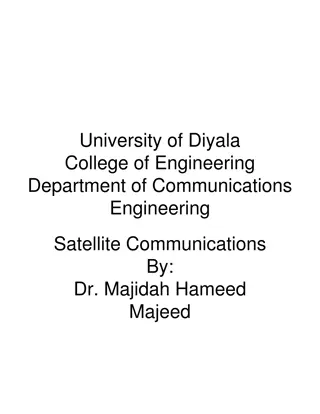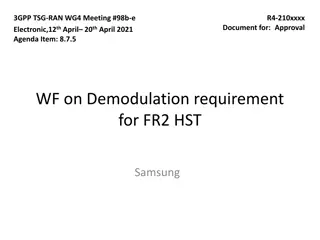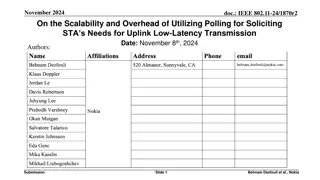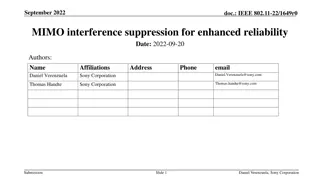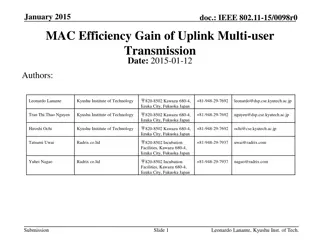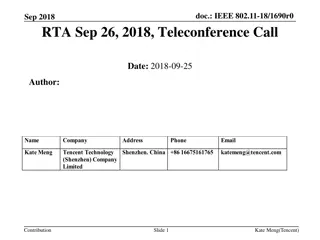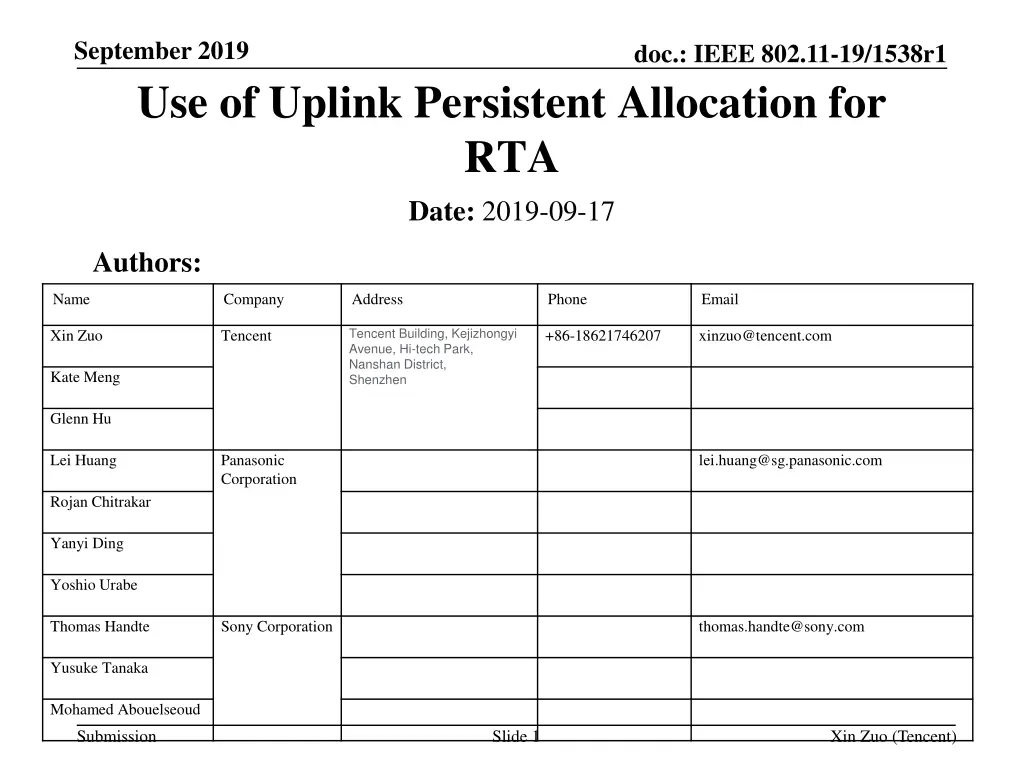
Uplink Persistent Allocation for Real-Time Applications in IEEE 802.11
Explore the use of Uplink Persistent Allocation (UPA) for reducing latency in real-time applications within IEEE 802.11 networks. This document discusses the challenges of meeting latency requirements, feasibility studies for applying UPA to different scenarios such as gaming and industrial automation, and proposes solutions to enhance transmission efficiency.
Download Presentation

Please find below an Image/Link to download the presentation.
The content on the website is provided AS IS for your information and personal use only. It may not be sold, licensed, or shared on other websites without obtaining consent from the author. If you encounter any issues during the download, it is possible that the publisher has removed the file from their server.
You are allowed to download the files provided on this website for personal or commercial use, subject to the condition that they are used lawfully. All files are the property of their respective owners.
The content on the website is provided AS IS for your information and personal use only. It may not be sold, licensed, or shared on other websites without obtaining consent from the author.
E N D
Presentation Transcript
September 2019 Use of Uplink Persistent Allocation for RTA Date: 2019-09-17 doc.: IEEE 802.11-19/1538r1 Authors: Name Company Address Phone Email Tencent Building, Kejizhongyi Avenue, Hi-tech Park, Nanshan District, Shenzhen Xin Zuo Tencent +86-18621746207 xinzuo@tencent.com Kate Meng Glenn Hu Lei Huang Panasonic Corporation lei.huang@sg.panasonic.com Rojan Chitrakar Yanyi Ding Yoshio Urabe Thomas Handte Sony Corporation thomas.handte@sony.com Yusuke Tanaka Mohamed Abouelseoud Submission Slide 1 Xin Zuo (Tencent)
September 2019 doc.: IEEE 802.11-19/1538r1 Background Uplink persistent allocation (UPA) has been proposed to be enabled for 11be UL MU transmission for overhead reduction [1] For an UPA, resource allocation information is unchanged for a time period. UPA can be used to shorten some specialized Trigger frames (e.g. BSRP, BQRP, etc) since the solicited UL OFDMA responses have small fixed size [1]. In this contribution, we propose UPA can also be used to shorten basic Trigger frames for soliciting TB PPDU transmission carrying RTA traffic. Submission Slide 2 Xin Zuo (Tencent)
September 2019 doc.: IEEE 802.11-19/1538r1 RTA Challenge RTAs are latency-sensitive. Several milliseconds could be desired. Challenging to satisfy the latency requirements There will be even more devices, more applications/services running over Wi-Fi networks in the future. Unlicensed spectrum. Even more challenging to satisfy the UL latency requirement. Basic trigger frame of 11ax could be helpful. Submission Slide 3 Xin Zuo (Tencent)
September 2019 doc.: IEEE 802.11-19/1538r1 Feasibility of Applying UPA to RTA 140 The statistics are collected at Tencent servers. Payload size (Byte) 120 RTA UL traffic pattern: Typical gaming: payload is a few hundreds of Bytes, and rarely larger than 500 Bytes. one service session lasting for a few minutes to ~20 minutes. 1~3 users under the same Wi-Fi in home, and many more, up to 10~20, in caf /restaurant/e-sport events. Therefore, the data rate required for gaming is about 10K~100K bps. A small fraction of spectrum resource can be assigned to RTAs as their UPA, for a relatively long period. HE-MCS 0 for 26-tone RU, either GI, could be sufficient for RTA UPA. 100 80 60 40 Data rate 10 Kbps -5 5 15 Tx time diff. ( 10ms) X-axis: the gap of transmitting time between two consecutive packets. Y-axis: the payload size. The area of the circle: the percentage. 140 Payload size (Byte) 120 100 80 60 40 Data rate 100 Kbps -5 5 15 Tx time diff. ( 10ms) 140 Payload size (Byte) 120 100 80 60 40 Data rate < 100 Kbps -5 5 15 Tx time diff. ( 10ms) Submission Slide 4 Xin Zuo (Tencent)
September 2019 doc.: IEEE 802.11-19/1538r1 Feasibility of Applying UPA to RTA Industrial automation: Data rate requirement is < 1Mbps [2]. Devices usually are simple, battery-enabled, etc. Could transmit data in the similar pattern for very long period, or the entire battery life. Many sensors/users under the same Wi-Fi network. Therefore, UPA may keep unchanged for relatively long time, to reduce the trigger overhead in UL. HE-MCS 0 for 26-tone RU, either GI, could be sufficient for RTA UPA. From the RTA TIG report [2]. Submission Slide 5 Xin Zuo (Tencent)
September 2019 doc.: IEEE 802.11-19/1538r1 Examples of Applying UPA to RTA Previous submission in 1118r1 [3] has also demonstrated the benefit of reducing overhead, based on the similar ideas. For a 11ax basic trigger frame containing X User Info fields, the shortened basic Trigger frame has a size of 30 + 1*X octets, reduced from 30 + 6 * X octets. MAC header: 16 octets Common Info: 8 octets User Info List: 6 octets * X (11ax basic Trigger) UPA Indication: 1octets * X (shortened basic Trigger) Padding: 2 octets FCS: 4 octets The reduction of overhead is ~14% (for 1 RTA STA), up to 56% (for 10 RTA STAs), equal to ~50 s, when the shortened basic Trigger is transmitted using MCS 0. Assume the same rate is used for transmission of 11ax basic Trigger frame and shortened basic Trigger frame Slide 8 in [3] Submission Slide 6 Xin Zuo (Tencent)
September 2019 doc.: IEEE 802.11-19/1538r1 Summary RTAs are usually latency-sensitive, and small in packet size. Trigger frame helps improve the uplink latency. UPA could reduce the basic trigger overhead in UL, especially when the number of RTA STAs is large. Submission Slide 7 Xin Zuo (Tencent)
September 2019 doc.: IEEE 802.11-19/1538r1 Reference [1] 11-19-0806-02-00be-enabling-persistent-allocation-for-EHT, July 2019 [2] 11-18-2009-06-0rta-rta-report-draft.docx [3] 11-19-1118-01-00be-enhancements-for-time-critical-data- transmission, July 2019 Submission Slide 8 Xin Zuo (Tencent)


